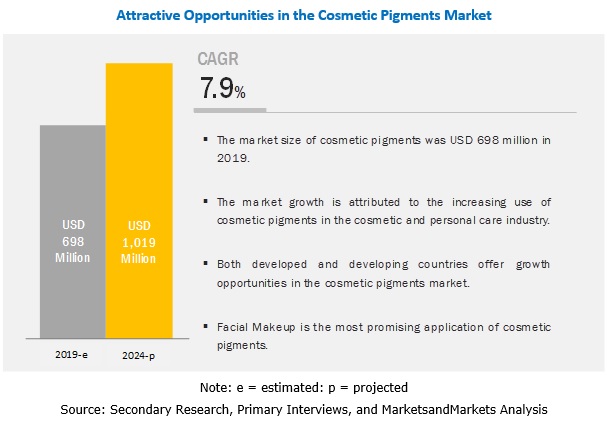Cosmetic Pigments Market by Composition (Organic, Inorganic), Type (Special Effect, Surface treated, Nano), Application (Facial Makeup, Eye Makeup, Lip Products, Nail Products, Hair Color Products), and Region – Global Forecast to 2024″, MarketsandMarkets: The cosmetic pigments market is projected to grow from USD 698 million in 2019 and expected to reach USD 1,019 million by 2024, at a CAGR of 7.9%.
Download PDF Brochure: https://www.marketsandmarkets.com/pdfdownloadNew.asp?id=179525453
Market Dynamics
Driver: Increasing demand for cosmetic pigments in cosmetic and personal care products
Cosmetic pigments possess characteristics such as bright and brilliant luster, shimmer, and shine. These pigments are colored, colorless, or fluorescent particulates. They can be organic or inorganic finely powdered solids. They are usually insoluble and are also chemically unaffected by the medium in which they are incorporated. They are used in a wide range of applications such as facial makeup, lip products, eye makeup, and nail products. The use of cosmetic pigments, especially pearlescent pigments, in facial makeup help cover blemishes and uneven skin tone. This has increased the demand for pearlescent pigments that are widely used in root makeup products.
Restraints: Stringent regulations pertaining to use of certain pigments
Cosmetic pigments manufacturers are required to follow stringent regulations regarding cosmetics products. There are different regulations regarding the specification of labeling, packaging, and the ingredients that are used in the manufacturing of the products. These regulations are especially stringent in Europe and North America. Other regions of the world are following the same trend due to the increasing health and environmental awareness. Owing to the strict regulations regarding the manufacturing of cosmetic pigments, the supply of these pigments is moderate. In addition, the approval process is time-consuming. All these factors restrain the growth of the cosmetic pigments market.
Opportunities: Consumer interest in environment-friendly and sustainably produced ingredients in cosmetic and personal care products
Several harmful chemicals are still being used as ingredients in makeup products. These chemicals may have an adverse effect on human health and can increase the risks of health hazard when several makeup products are used together. A combination of increased public interest and market trends in the cosmetics industry has led the cosmetics manufacturers to seek more natural and sustainable cosmetic emulsifiers.
Challenges: Maintaining quality of cosmetic pigments for mass market products
The cosmetic pigments market is growing due to the increasing demand for color cosmetic products. However, there are a few challenges faced by the market players. The biggest challenge that the cosmetic pigments manufacturers face is maintaining the quality of cosmetic pigments for mass-market products such as nail paints, lip colors, and eye makeup products.
APAC is the fastest-growing market, in terms of both production and demand. Higher domestic demand, easy availability of raw materials, and low-cost labor make APAC the most preferred destination for the manufacturers of cosmetic pigments. The use of cosmetic pigments as an important additive in various applications such nail products, lip products, eye makeup, facial makeup, hair color products, special effect & special purpose as is driving the market in China. APAC is emerging as a leading consumer of cosmetic pigments due to the increasing demand from domestic as well as international markets.
The key players in the cosmetic pigments market include Sun Chemical (US), Sensient Cosmetic Technologies (France), Merck (Germany), BASF (Germany), ECKART (UK), Sudarshan (India), Kobo Products (US), Clariant (Switzerland), and Geotech (Netherlands). These players have established a strong foothold in the market by adopting strategies such as expansion, new product launch, and merger & acquisition.
To speak to our analyst for a discussion on the above findings, click Speak to Analyst



